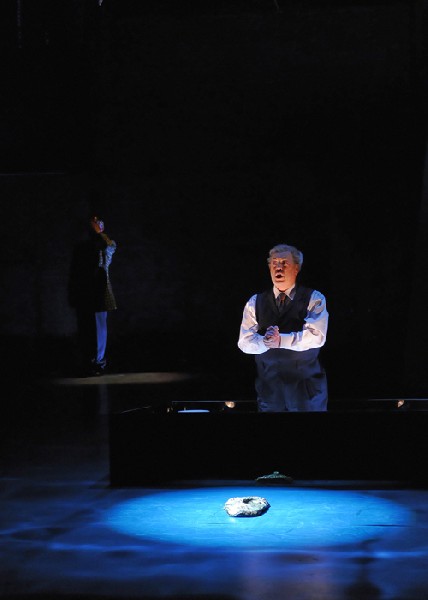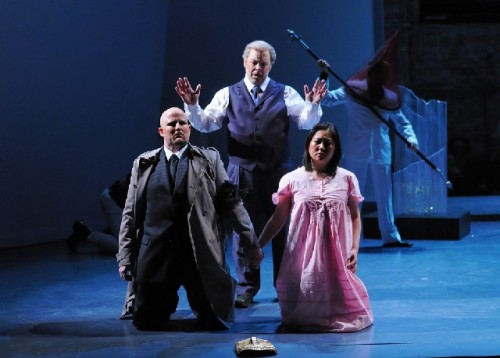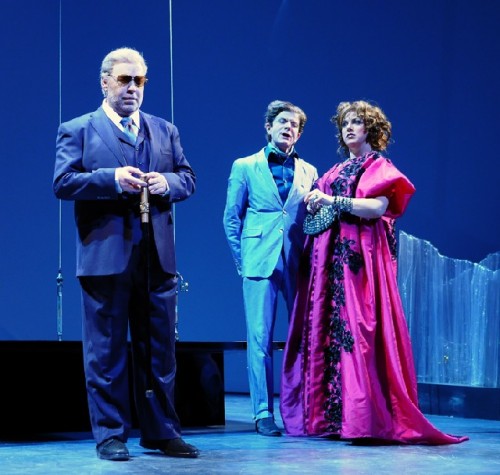Hindemith' s Cardillac at Opera Boston
Rarely Staged and Now We Know Why
By: David Bonetti - Mar 03, 2011
Cardillac
by Paul Hindemith
Opera Boston
The Cutler Majestic Theatre
Performances Feb. 25 & 27, March 1
Opera Boston’s production of Paul Hindemith’s 1926 opera “Cardillac” answered the question about why the work is so seldom done: It just isn’t all that great.
The failure of the music drama to enter the repertory alongside such more or less contemporaneous works as Strauss’s “Elektra” and “Salome,” Schoenberg’s “Erwartung,” Berg’s “Wozzeck” and “Lulu,” Weill’s “Three Penny Opera” and “Mahagonny,” Shostakovitch’s “Lady Macbeth of Mtensk’ and Puccini’s “La Fanciulla del West” is not the fault of Opera Boston, which gave its all to its realization. From the superb orchestral playing and the passionate conducting of Opera Boston’s music director Gil Rose to the committed singing of the entire cast - but especially Sanford Sylvan, for whom the production was mounted - to the well-conceived and well-executed stage direction, one could not have hoped for a better production of a tough modern opera. Additionally, the production helped fulfill the company’s commitment to presenting neglected operas. “Cardillac” is a rarity that was at the top of the list of operas I looked forward to seeing this season in Boston. Now that I have, I don’t have to ever again. But I remain grateful that I had the opportunity.
Musically, the opera had its moments. The much-cited flute duet that accompanied a sado-masochistic coupling of “The Lady” and “The Cavalier,” a lyrical aria by “The Lady” about the passage of time accompanied by oboe and strings, a quartet in the third act that displays Hindemith’s mastery of classical form and a conclusion that recalls Lutheran church music come and go all too quickly. The orchestration is winds-heavy, which gives it a modern sound, and it includes a saxophone, which tracks Cardillac, the only character with a name. For the most part the orchestral writing is of the type I call “moving right along” music that fills time in opera. Bel canto composers like Rossini and Donizetti are criticized for such musical filler. I think it’s fair that Hindemith be too, even if his toodling is spikier and more abrasive – the style of his time. But there are no moments when the music, the text, the performance, the production come together to create something greater than the sum of its parts, the kind of unforgettable, incandescent moments that allow operas to take their place in the repertory.
Dramatically, the opera is based on a promising notion: an artist who can’t bear to live without his creations murders his clients to get them back. (Cardillac – which is pronounced “cardi-yac” – is the greatest goldsmith of his time.) The story is based on a novel by E.T.A. Hoffmann, who is better known for his fairy tales. His “Das Fraulein von Scuderi” was one of the first murder mysteries ever written and remains popular among German speakers; although murder is the subject, it is treated as if in a fairy tale. Hoffmann set the novel in Paris, as Hindemith did his opera, but there’s no disguising the fact that this is a very German work.
The story allows all sorts of philosophical questions to be posed, the relationship between the artist and society and the nature of creativity primary among them. It is clear that Cardillac sees himself as a Nietzchean superman, above the laws that govern ordinary men and women. At one time he sings, matter-of-factly, “I create and I kill.” His brainwashed daughter sings that her father gives life to objects like a god. The ethically most problematic expression of this very debatable idea comes at the opera’s conclusion. After Cardillac has been killed by a mob when he confesses that he is the killer who has terrorized the buyers of the luxury goods he produces, he is proclaimed a hero by his daughter. Historically, it is true that artists are often not held to the ethical standards of ordinary people. Both Caravaggio and Benvenuto Cellini, the Florentine goldsmith who was probably an inspiration for the character of Cardillac, were murderers. But still, Hindemith’s rather cavalier treatment of Cardillac’s career as a serial killer is a little chilling considering the events that would soon overtake Germany.
If the premise is rather simple, the opera needlessly complicates it. With three acts, the work takes only 90 minutes, and Opera Boston wisely presented it straight through without an intermission. But a simpler, more direct libretto might have made it a more successful one-act work. (Hindemith’s earlier operas were one-acters.)
The third act particularly is muddled with philosophizing and plot complications. Maybe it was because I was losing interest, but at one point I completely lost track of what was transpiring on stage. Hindemith rewrote the opera in the 1950s, adding a fourth act but otherwise streamlining it. The consensus is that the revision was not an improvement, but at least the composer, who was a long time teacher at Yale, acknowledged the problems of his youthful attempt at a full-evening opera.
The cast was well matched. Sylvan gave a cool performance of a man without emotion about anything other than his handiwork. His suave baritone was impressively nuanced. This was simply an example of great singing. Sol Kim Bentley was solid as the Daughter, her voice particularly beautiful in the high lyrical singing of the final scene. Particularly enjoyable was Janna Baty as The Lady, who brought a louche sexiness to her role as femme fatale and lushly lyrical singing to her all-too-brief aria. The rest of the cast – Frank Kelley as The Cavalier, The Lady’s willing sexual victim; Steven Sanders as The Officer, The Daughter’s true-love; and David Kravitz as the Gold Merchant – were all excellent.
The production was stylish – slanting walls and long shadows recalled the tropes of German Expressionist film. The production made one successful change from the original. Instead of a gold belt being the object of desire that brings Cardillac to mob-inflicted justice, it substitutes a gold mask. Its use aids in giving a more mythic quality to the proceedings. But it couldn’t, alas, help make the opera something you’d want to see again.





